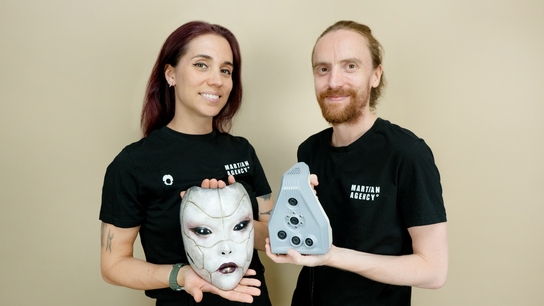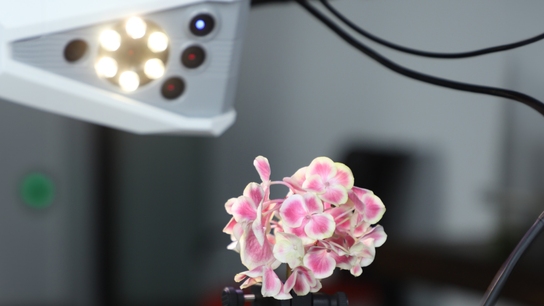Scan the World with Artec Eva, hosted on Google Arts & Culture
Challenge: A London initiative Scan the World wanted to create an ecosystem for everyone to be able to freely share digital, 3D scanned cultural artifacts for physical 3D printing – making art accessible to all.
Solution: Artec Eva, Artec Studio
Result: With Artec technology, STW travels the world to scan items in art galleries from London to Limerick, Milan to Madrid.
Why Artec: A versatile solution, Artec Eva allowed the team to walk through galleries, capturing data from sculptures, and easily processing them later on Artec Studio.

Using Artec Eva to digitize the world, one sculpture at a time
Only about 1 percent of museum collections are on display. Of those that make the cut, glass cases and “Do Not Touch” signs make clear: these precious items are for viewing only, and only under certain terms. For a long time the understanding has been that if you’d like to look at, you have to go to.
One ambitious London-based initiative has set out to change that.
“Scan the World is a project which came off the back of an arts initiative that was running about eight years ago,” Founder and Manager Jon Beck said. “It’s basically about harnessing democratized technologies – such as photogrammetry using our smartphones – in order to share stories of heritage with the world.”
As a crowdsourced project, Scan the World invites users from all over the world to contribute their own 3D models of sculptures and artworks in museums and galleries. These methods range from mobile-phone photogrammetry captures to professional 3D scanners. These models can then be downloaded, 3D printed, or used in any number of ways.
“It’s about harnessing democratized technologies in order to share stories of heritage with the world.”
“I wanted to be able to set artwork free through these democratized technologies, but then also to make artwork, and copies of the artwork available, for anyone to consume,” said Beck.
Getting on with Google
From its origins, the idea behind Scan the World grew, capturing attention from the likes of Google and Wikipedia. And with big names comes greater accessibility.
“We collaborated with Google Arts and Culture, and Wikipedia, and as a small arts project who were suddenly getting work with [these household names] and a lot of great museums, getting that credibility meant that we could scale up the way that we were scanning,” explained Beck.

Scan the World’s 3D models are featured and hosted on Google Arts & Culture
“Google Arts & Culture came to us because we are so open and caring about the community; they wanted to help us with broadcasting our digital collection as widely as possible.”
With the support of Google and the publicity it brought, more museums warmed to the idea of sharing their work with the team, who were then able to create more stories to tell, and to share them as widely as possible.
“Google Arts & Culture wanted to help us with broadcasting our digital collection as widely as possible.”
“I think it’s very important to have these stories disseminated in as many places as possible. And what we’re trying to do at Scan the World,” Beck said. “To sort of focus on object-based narratives, and the communities that come out of these different genres of artifacts.”
And while a Google partnership allows them to elaborate on their work and the stories they tell, Scan the World sticks firmly to their own story: that the tales need to be in the hands of the community.
“We don’t want to control, or curate too much,” Beck said, “It’s more of a sort of storytelling of putting our community on a pedestal I suppose – and showing off the sort of most heartfelt or the most exciting stories that we have done over the past eight years.”
How Artec is used
With names like Google and internally renowned museums in the mix, Scan the World then set their sights on high technology. Already familiar with Artec technology from previous projects, Artec 3D as a solution wasn’t a far reach when it came to finding the perfect tool to use.
“We were looking for certain techniques or methods that we could use in order to scan high quality en masse and with ease, which is where we looked towards structured-light scanning,” Beck recalled.
Their tool of choice: the Artec Eva. Artec 3D’s flagship scanner, Eva is an ideal scanner for capturing precisely the sort of items you’d find in a museum: sculptures, busts, ornaments, relics, and more. Light, fast, and accurate, Eva (and all other Artec scanners) are safe for any surface or object. This leaves you with untouched, unmoved, and undisturbed items that are fully captured in 3D, then processed into high-definition, fully textured 3D models.
“As you walk around the museum space with Artec Eva, you can collect and acquire perfect data.”
“Firstly, it’s the fact that you can never really get a poor scan from the Artec Eva,” said Beck. “But it’s also the fact that as you walk around the museum space, you can feel free to be able to just collect data, and acquire perfect data, right there and then.”
This stands in contrast to other types of scanners that they’ve worked with in the past that have had a higher level of entry or a huge learning curve, making it difficult to acquire immediate and good results.
“With Artec scanners, it’s also very hands-on,” Beck said. “It’s the easiest tool to show to people who haven’t actually used 3D or digital technologies within a museum space.”

Capturing sculptures with Artec Eva at the London Sculpture Workshop
The process is easy as well.
A recent example is Scan the World’s work with the Statens Museum in Copenhagen. Having traveled to Denmark for the project, time was of the essence, and accurately capturing as much as they could was tantamount to success.
With Artec Eva, there was one less thing to worry about. “It was possible for us to not have to worry about quality control, as we had full trust in the Artec Studio software, and so we were able to scan a lot in the space of one day, and then process that data later,” Beck said.
Besides being easier and more comfortable timewise, the Artec solution was also more cost effective – even when staying only for a short period of time, the team was able to digitize close to 80 artifacts a day.
“What’s most beautiful? It’s the software.”
The simplicity of Artec scanners – and intuitive algorithms in Artec Studio software – is key to this success. “I might work in tech, but I’m not the best at it,” Beck laughed. “But what is most beautiful about scanning with an Artec scanner? It’s the software.”

Having access to this technology creates opportunities for artists and creators all over London and beyond
With Artec Studio, Beck described, it’s a simple step-by-step that encourages you as you process, while optimizing the data for you. While HD Mode has meant a huge improvement in how data looks overall, what’s also essential is being able to work on one section of a scan, or being able to come back and add more scanned data later.
“All this versatility really helps with my overall workflows.” Beck said. “And with the yearly updates to Artec studio, it feels like every year I'm getting a new product. It means that there’s a new toy that I can play with, and also return back to old scan projects and use them again.”
Scanning the future
Currently, the Scan the World database has about 25,000 3D models captured from across all continents, 5,000 of which have been scanned by the core team with Artec Eva. “How Artec helped is that we have been able to create such a huge quality difference from what we’ve had in the past, and what we’ve been able to get now and are creating,” Beck said.
“We’ve got such incredible digital reproductions of artwork, and they are almost perfect replicas! The quality of the facsimiles that we can now create? Thanks to this tech, we’ve been able to really get high-quality and dimensionally accurate, valid digital copies of heritage.”
Scanners behind the story
Try out the world's leading handheld 3D scanners.





